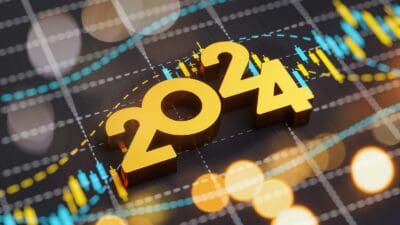Though it’s only mid-February, 2023 is a landmark year for the FTSE 100 index. After almost five years of waiting, the index finally beat its May 2018 all-time high. Also, it broke another major milestone on Wednesday afternoon.
The FTSE 100 breaks 8,000 points
At about 3.40 pm today, the FTSE 100 briefly broke through the 8,000-point mark for the first time ever. It peaked at 8,003.65, before dropping back to 7,996.36.
But why is this a big deal? Why should one price level be more important than another? And don’t rising asset prices today translate into lower returns in the future?
I suspect that the Footsie pushing past 8,000 has some significance. As humans, our psychology draws us to round — and particularly very round — numbers. Remember the huge global party celebrating the year 2000 and the start of a new millennium?
What’s more, investor psychology is also affected by widely covered and positive news like this. Indeed, ‘momentum’ investors actually prefer to buy as prices are rising. So this news may lure in more ‘dry powder’ — money sat on the side-lines, awaiting opportunities.
A quick history of Footsie milestones
Then again, FTSE 8,000 has been a long time coming. At end-1999, the index closed at 6,930 — a record closing high. It then more than halved during the dotcom crash of 2000-03.
The London market then rebounded strongly, hitting a post-crash peak in mid-2007. But then the global financial crisis brutally collapsed stock markets again in 2007-09. After a long wait, the FTSE 100 hit a new record high of 7877.45 on 22 May 2018, before retreating once more.
The FTSE 100 moved up and down, and often sideways, until the spring of 2020. As Covid-19 infections swept the world, global stock markets underwent a short, sharp crash. But thanks to massive fiscal and monetary stimulus, the index soared skywards again.
Here’s how the UK’s main market index has performed over these five time scales:
| One month | 1.7% |
| 2023 YTD | 7.3% |
| Six months | 6.1% |
| One year | 5.0% |
| Five years | 9.6% |
My table shows the Footsie delivering positive returns in all periods ranging from one month to five years. To be honest, I can scarcely remember the last time I recall this happening. In short, the index has dodged the meltdown seen in other major markets. But why?
I still see the Footsie as cheap
I can offer three reasons for the index’s resilience. First, it include several mega-cap multinational companies whose global earnings are largely immune to the UK’s domestic issues. Indeed, perhaps 70% to 75% of the index’s earnings come from overseas.
Second, the FTSE 100 is packed with ‘old economy’ firms, such as oil & gas producers, miners, banks, and insurers. And these ‘boring’ value shares largely avoided last year’s widescale collapse in tech shares.
Third, I still see the Footsie as cheap today, both in historical and geographical terms. After all, it trades on a price-to-earnings ratio of 12 and an earnings yield of 8.3%. That’s look pretty inexpensive to me.
Finally, the FTSE 100 offers a dividend yield of almost 3.7% a year, which is considerably higher than many other major markets’ cash yields. And that’s why I keep on buying cheap Footsie shares!








